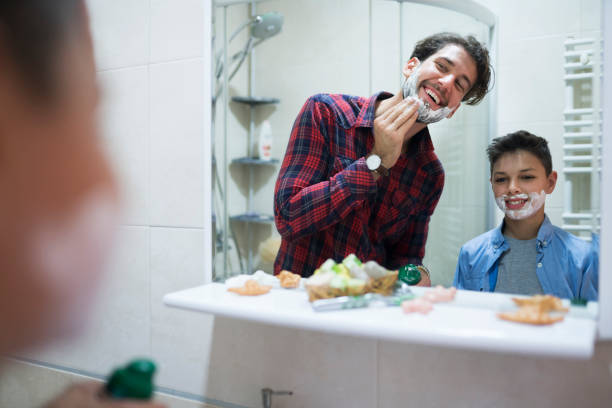
How to Teach a Teenage Boy to Shave?
As soon as your kid reaches puberty or the adolescent years, it may be time to start teaching him how to shave. Some people begin shaving as soon as 12 or even earlier. You can start teaching him to shave as soon as you notice long hairs growing on his chin or upper lip, or if he develops a peach fuzz on his face. Tell your son to shave the edges to achieve a neat appearance even if he wishes to grow a beard.
Typically, guys don’t start growing facial hair until they are well into puberty, which is around age 14 or so. However, some boys may need to start shaving as late as their late tween years. In either case, prepare yourself with a few helpful shaving pointers to teach your youngster how to shave properly and securely while adhering to good hygiene.
Table of Contents
How to Teach a Teenage Boy to Shave?
When showing a boy how to shave for the first time, follow these instructions:
Select a Reliable Razor
In this case, there are only truly two options: electric or blade razors. With electric razors, your youngster is less likely to accidentally cut themselves. They are also practical because shaving cream and other preparations for shaving the face are not necessary. Electric razors can be pricey and may not always provide the closest shave, which is a drawback. Blade razors often produce a closer shave, although your youngster may not care about that just yet.
Get the Face Ready
Your youngster must clean his face before shaving if he chooses to use a blade razor. Before attempting to shave, he needs to moisten his face and apply shaving cream. Never shave an unprepared face because it could lead to wounds and skin discomfort.
Because your teen might be struggling with acne, oily skin, or other skin issues, choosing the correct shaving cream can be challenging. Before selecting a product that is suitable for his skin type, he might need to try a few different ones.
Improve Your Technique
Short, delicate strokes work best when shaving. The skin should be smoothly cut by the razor. To avoid nicks and cuts, advise your tween to shave against the direction of hair development. He can shave more closely by going against the hair growth after he feels more comfortable with the razor.
In order to maintain the razor clean and avoid nicks, make sure your youngster rinses it after each stroke. Your youngster should use a fresh, soft towel to pat his skin dry after shaving. Facial rubbing is not acceptable. Best are soft pats. Before using an aftershave, give the skin a chance to breathe.
Use less aftershave
Using lotion or aftershave is acceptable, but young skin might be extremely sensitive. Look for an aftershave that is developed for sensitive skin and is alcohol-free. Be cautious when selecting an aftershave because a strong perfume may irritate your child’s skin.
Sharpen the Blades
If your child chooses to use a blade razor, instruct them to clean it off after each use and dry it with a towel. To prevent cuts or nicks to the skin, disposable blades should be thrown away after the fourth or fifth usage.
Share No Razors
It goes without saying that you should never share your razors with others in a collection of shaving advice. Infection is only one of the issues that might arise from sharing razors.
Avoid going too far
For a while, your son most likely won’t need to shave every day. All that may be required is once each week. Encourage him to only shave when absolutely necessary to prevent needless skin irritation.
More Advice For Young Men Shaving
While assisting your son in mastering the technique of shaving, keep the following in mind:
- To observe his brushstrokes and identify critical areas, have your kid first shave in front of a mirror.
- Encourage him to try shaving in the shower once he feels more at ease because the wet air enhances the sensation and results.
- Encourage your son to unwind, hold the razor tenderly, and let it work.Boys may feel anxious the first few times they shave. As a result, they could irritate you by applying too much pressure to their face.
- Discuss hygiene.Make sure he understands that his razor is a personal thing and that he should never lend it to a friend or borrow another person’s. Cross-contamination, illness, and other problems come from sharing razors.
- Have your son begin slowly.Even though he may be eager and enthusiastic about this new practice, it shouldn’t be done every day. He ought to just shave when necessary. Keep in mind that teenage skin is sensitive, so he doesn’t want to chance discomfort or breakouts.
- Make sure your son records how frequently he uses a disposable razor before switching to the following one.Overuse can wear down the blade, making for a harsher shave and raising the possibility of injury.
Shaving is like growing up and going through puberty in general; both require some learning. Your son will need some practice to get the hang of shaving, but ultimately he’ll be an expert. In the interim, you’ll assist him in getting through this phase largely uninjured with your assistance and astute advice and tricks.


